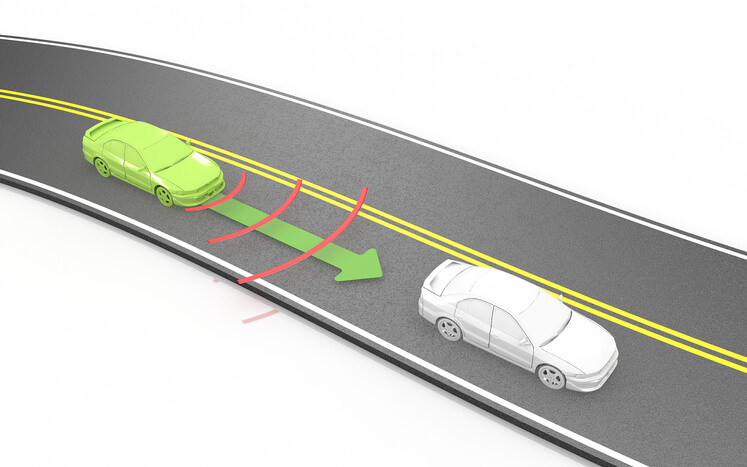Anyone who drives, especially new drivers, should have some basic skills when it comes to their vehicle. Your tires are the most important part of your car. They are the only contact point between you and the road. All kinds of hazards can cause a flat. So, how do you change a tire by hand? We can help you in 10 simple steps.
1. What Do I Do First?
First of all, if you get a flat tire, do not panic. You will know your tire is flat because your car will start to vibrate erratically or have a wobbly feeling in the steering wheel. Do not drive any farther than you need to safely pull over. While driving engage your hazard lights. This is the button on your car’s center stack with a red triangle symbol.
Pull over to the side of the road as quickly as you can. Find as flat a spot as possible. If you’re on a freeway or busy street, pull your vehicle as far off the road as you can. This is especially true if your flat is on the side of the car facing traffic.
Some cars come equipped with safety flares or reflective triangles. If you have one, don’t be afraid to use it so drivers moving at fast speeds have enough warning of your presence.
When you have found a spot, stop your car and turn off the engine. Set the parking brake on to the Park position. If you have a manual transmission, put the car in first or second gear to prevent it from rolling.
2. What Do I Need to Change a Tire By Hand?
Before heading out anywhere, a prepared driver knows exactly where their emergency equipment items are. (Note that some newer cars do not come with a spare. They might have a fix-a-flat product that you spray into the tire to temporarily patch it. Make sure you know if you have a spare tire or not.)
Locate the tire iron, jack and spare tire in your vehicle. What kind of vehicle you have can determine the location of these items.
Trucks can house the spare underneath the bed. In sedans or SUVs the spare is generally located in a compartment under the cargo floor. Set your spare down flat. You don’t want it rolling away from you, especially if you’re on a busy street.
3. Where Do I Place the Jack?
Placing the car jack is very important when you’re changing a tire by hand. You must put it under the metal frame or chassis of the car. Parts of the car’s body are often made of plastic or thinner metals and can break or bend under the weight of the car. If you aren’t sure where a good point of contact is, check the owner’s manual.
On newer cars there can be a specific spot where the jack goes. For older cars make sure it’s underneath a beam that travels the length of your vehicle.
Raise the jack up until it’s touching and supporting the car but not yet lifting it.
4. What Do I Do After the Jack is Secured Under the Car?
Remove any hubcap the wheel your flat tire might have to expose the lug nuts.
Use your tire iron to loosen the lugs with counter clockwise turns. If these are too hard you can use a breaker bar, but hopefully that won’t be necessary. Chances are you won’t have one handy. You can also use your foot to provide added pressure. Be careful not to push too hard. You could strip the lugs of their threads.
Only loosen the lug nuts. Do not fully remove them. With the lug nuts still loosely on, crank or pump the jack to lift up the car. The tire should be just off the ground. It only needs to be high enough to remove the tire.
Double check that your vehicle remains stable as you’re jacking it up. If you notice it’s not firmly on the jack or at an angle then lower the car. Reposition the jack and start again. Try and keep a jack stand in the car to keep things really safe. A jack stand is a solid steel stand that goes under the car securing the frame. It adds extra safety to the jack.
5. How Do I Remove the Tire?
When the tire is completely free of the ground, remove the lug nuts all the way. Make sure you put them somewhere you won’t lose them or they won’t roll away. You’ll need these later. A pocket or small container work well.
Remove the tire. Be careful how you lift it. Make sure you use your legs and not your back. Tires and wheels can be heavy depending on their size. Make sure to lay the flat tire down flat. Again, you don’t want it rolling away especially if you’re on a busy road.
6. How Do I Put the Spare Tire On?
Get your spare tire and make sure it’s oriented the correct way around and not backward. That means to make sure the valve stem is facing out toward you and not inward. Be prepared again to lift properly. Don’t put out your back.
Line up the lug nuts with the bolts and push the tire onto them. Hold the tire in place with your hand while you get your lug nuts. Put them on one at a time in a star pattern. Do not put them on in a clockwise fashion. They might not go on evenly.
If you have acorn nuts then the tapered side goes on first. Hand tighten the lug nuts in a clockwise fashion. Again, tightening all of them in a star pattern. Only hand tighten the lug nuts at this point. Do not tighten them all the way.
Do not push against the tire too hard when you’re reinstalling the lug nuts. Too much pressure could push the car off the jack stand or jack.
7. What Do I Do Once the Spare is Securely On?
When the wheel and tire are in place, keep the car jacked up and remove the jack stand if you used one. Always exercise extreme caution when getting anywhere underneath your vehicle.
When everything is clear from underneath your car, that includes your feet, lower the car using the jack until it’s almost onto the ground. Do not lower it completely yet.
Tighten the lug nuts a bit tighter with a tire iron or a socket wrench before putting it fully onto the ground. Again, perform this function in a star pattern, not counter clockwise or clockwise.
When the lug nuts are more securely tighten, then lower the vehicle the rest of the way onto the ground. Make sure the jack is fully retracted before trying to remove it. You want it to be completely clear of the car.
8. What Do I Do After the Car is Back on the Ground?
Remove the jack. Finish tightening the lug nuts with the tire iron. This is preferably a job for a torque wrench. You can over-tighten lug nuts. If you had trouble initially removing them, you know this first hand. Make sure they are tight, but not over torqued so no one can get them off in future.
Replace the hubcap if you have one. If your spare is the small donut size emergency tire, replacing the hubcap might not be necessary or possible. With those emergency spare tires, you should only drive enough distance to get your vehicle to a shop that can help with a replacement tire.
Replace the tire iron, jack and jack stand to their proper places before anything else. Usually, cars will have specific places for these items. This is not just for convenience so you know where they are for next time. These are heavy items, and if they’re not properly secured could cause damage to your car or a passenger if they’re simply thrown in the back seat.
When you’ve got everything put away, put your flat tire in the trunk of your car. Remember to lift it very carefully, not using your back.
9. What Should I Do Once the Tire is Changed?
When you’re done, turn off your hazard lights and head straight to a mechanic. If you’re driving on the small emergency donut tire, do not exceed 55 miles an hour. More importantly, do not drive on it for any extended period of time. Because the size and air pressure in the tire is different from your other tires it might cause uneven wear on the remaining three tires. Then you would need four new tires. Also, if you’re driving around on your spare and you get another flat, you have no spare to work with.
Once you get to a tire shop or mechanic, they can test to see what the problem is. You might have just a small puncture that can be repaired for around $20. If not, the mechanic or tire store will replace the old tire on the wheel for you and recycle the old tire properly. Do not throw tires away.
10. What Else Is Important to Know?
The entire process of changing a car tire by hand should take between 10-20 minutes depending on whether you’ve done it before. However, if it’s taking longer, do not rush things. Take your time. Especially for a first timer, it can be a complicated process. Missing a step will make it even harder.
Your overall safety is the most important part of changing a tire by hand. If you’re not comfortable with the process or are in an area where you think it’s dangerous to get out of your car, don’t risk it. Call a parent or friend or roadside assistance for help.
Lyn Woodward is a writer and video host reviewing new sheet metal. Driver’s Ed was the easiest A she ever earned. She's the proud owner/mechanic of a 1966 Datsun Fairlady Roadster and 1987 Mitsubishi Montero. Her superpower is parallel parking and folding fitted sheets. Before writing about cars, she wrote three made-for-television movies.

















